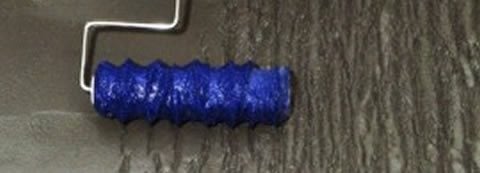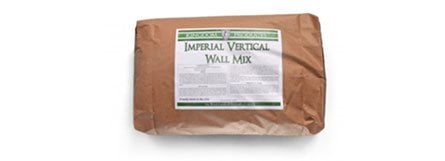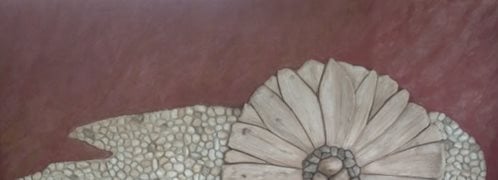Handcarved Concrete: Taking Vertical Concrete to the Next Level
From Creative Rock Forming in Hickory Hills, ILHandcarved vertical concrete is one of the newest trends in concrete, and Nathan Giffin, owner of Creative Rock Forming, is helping to develop that trend. "I first saw handcarved concrete eight years ago from a friend in South Africa who had his own business carving on walls. I thought it was something that would only be recognized and accepted in zoos or naturescapes. The style of it fit perfectly with South Africa, but the colors, styles and shapes didn't really fit with American culture and design." What Giffin recognized however, was that there was a huge market for this in the U.S.-no handcarving vertically was being placed. "I couldn't find it anywhere in the decorative concrete industry," he says.
So eight years ago, Giffin started Creative Rock Forming. "I had to practice and learn the hard way," he explains, "but I was able to create a style and method of my own." Now Giffin has turned basements into stone coves and old closets into wine cellars. "I can make a cellar look like it was built 200 years ago," he says.
The Handcarving ProcessGiffin's first step on a project is to ask his clients what kind of stones they like. "They look at my portfolio and can see examples of big or small stones, or a combo of both, stacked stone, roman-like, or random, etc.," he says. "I state in my contract that every stone is original and unique—handcarved and colored." Giffin notes the most popular design is the look of old, Italian buildings. "People like the Tuscany look and the exposed rock look. It's also very popular for wine cellars," he says.
Giffin then begins by trowelling on a proprietary mix he created on the substrate. "I usually put it up 1 ½ to 3 inches thick," he says. "You can't get the relief you're looking for, like deep crevices, without a lot of material to work with."
Next, Giffin textures the surface. "I make my own skins for texturizing," he says. "For carving, I use a variety of other tools such as brushes, point trowels, rounded pool trowels, etc." Giffin uses skins and stamps to give original textures, and then handcarves to give the rocks shape and character. "The process is fairly simple," he explains, "but it's tasteful, and looks realistic."
Giffin says handcarving is a bit more involved than using regular stamps on vertical substrates. "It probably takes about 30% more time than traditional vertical stamping," he explains. "A couple hundred square feet might take one week from start-to-finish." But Giffin feels traditional stamping can't achieve the same natural, realistic effects. "Too many people are trying to take regular stamping mats they use on flatwork to create faux rock walls. They end up looking cheap, fake and repetitive," he says. "Using regular stamps rather than handcarving is like going back to using modems rather than using cable. Why go back to regular stamping when you can give clients a more authentic, realistic look with carving."
For achieving these realistic looks, Giffin explains that he gets his texture and rock formation ideas anywhere and everywhere. "I'll pull off the road if I see a neat rock with a big crack in it," he says. Also, with his background in faux finishing, texturing and painting walls, Giffin knows just how to manipulate colors and textures to get the most realistic finish. He says, "It's good to have texturized rock and stone, but if you don't have variety in the faux coloring, everything will look the same."
Giffin uses a variety of techniques and systems for his faux finishes. "I'll use acid stains and acrylic to water-based stains, and latex paints all on one job," he explains. "And I use various methods for applying the color—brushing, spraying, sponging, spritzing—all to get different effects. I also use powder release, not for the dominant color, but for setting off and creating depth."
Giffin says he uses a variety of products, but mentions that "Boulder Formation has a nice acrylic set. I like Butterfield for their Essence line of colors and stains, and I like Brickform for their acid stains."
Handcarving Concrete Opportunity Giffin sees endless opportunity in handcarved concrete. "Vertical is pretty much untapped," he says, "because the design possibilities are endless." Giffin is trying to establish a foothold in the interior market within the Chicagoland area. "I noticed that people will spend more on the inside of their home than on the outside, on their interior walls and floors rather than on their driveways and patios." Giffin mostly focuses on interior projects with his rockwork. Giffin also markets himself with local home builders. "I'm the 'feather-in-the-cap' of builders that can offer this product to their clients, and I can come in and transform these rooms."
Giffin's passion for developing the vertical concrete market has led him to offer online training for other contractors. "Gone are the days when you have to spend $400 for a stamp set for one look. I can teach contractors to create lots of different looks with the same textures and tools." Giffin is currently developing a website where contractors can access a forum, read case studies of projects with step-by-step information, watch videos, and more.
Giffin is on the cutting-edge of the vertical concrete trend, and credits his inspiration to Spanish architect Antoni Gaudi. "I've always been fascinated with architecture," he explains. "I was particularly inspired by Gaudi. He inspired me to stretch the envelope. Gaudi created things people didn't think they were ready for. Once they saw it, they loved it." Now with vertical concrete, Giffin is getting the same reaction with his work.
Creative Rock Forming
Nathan Giffin
708-233-9394
Submit Your Own Project Photos
Read More About Vertical Concrete
 Vertical Overlay Texture Tools
by Butterfield Color
Vertical Overlay Texture Tools
by Butterfield Color
 Vertical Wall Mix
40 lb Bag
Vertical Wall Mix
40 lb Bag
 Brickform Vertical Mix
Great for Carving or Stamping
Brickform Vertical Mix
Great for Carving or Stamping
 Butterfield Cantera Wall Mix
Just Add Water
Butterfield Cantera Wall Mix
Just Add Water










